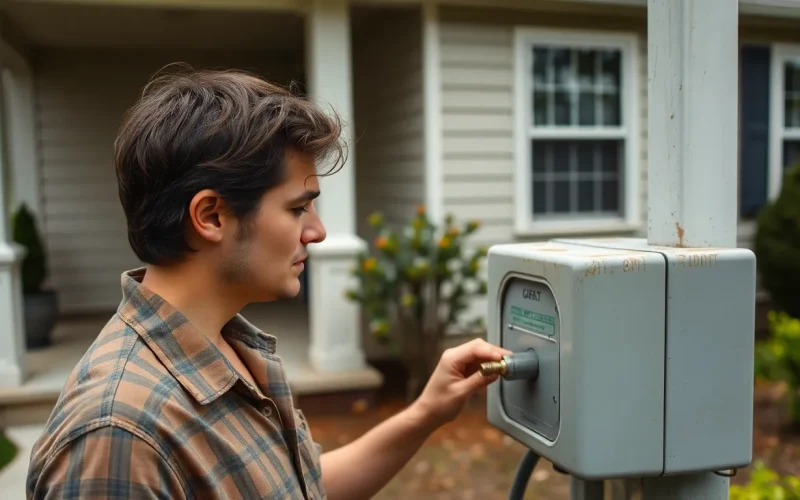Table of Contents
ToggleWhen it comes to home safety, knowing how to shut off the gas to your house is as crucial as knowing where the fire extinguisher is—though hopefully, you won’t need either anytime soon! Gas leaks can turn a cozy evening into a scene straight out of a disaster movie. But fear not! With a little guidance, anyone can become a gas-shutting-off superhero in their own right.
Understanding Gas Valves
Understanding gas valves is crucial for safely managing gas supply in a home. These valves control the flow of gas, allowing homeowners to shut off gas when necessary.
Types of Gas Valves
Two main types of gas valves exist: manual and automatic. Manual valves require physical operation to open or close. Automatic valves, on the other hand, function based on pressure changes or specific conditions. Each valve type serves the same primary purpose: regulating gas flow. Homeowners typically find manual valves easier to locate and operate. Automatic valves offer added safety by closing in emergency situations, minimizing the risk of leaks.
Location of Gas Valves
Gas valves usually reside near gas appliances or in utility areas. Valves commonly install near the gas meter, making them accessible in emergencies. In some homes, additional valves may be present at individual appliances, like furnaces and water heaters. Accessing these valves requires knowledge of their locations to act quickly. Homeowners should regularly check and label valve locations for easy identification during emergencies. Understanding where these valves are positioned enhances overall safety in gas management.
Safety Precautions

Prioritizing safety when dealing with gas appliances ensures protection for both individuals and property. Understanding the necessary measures is crucial.
Personal Safety Measures
Wearing protective gear is essential when handling gas. Use gloves and safety glasses to protect against leaks or spills. It’s important to stay calm and avoid using any electrical devices that could create sparks. Checking for signs of gas leakage involves listening for hissing sounds or smelling for sulfur, which indicates a problem. If potential leaks are suspected, evacuate the area immediately. Calling a professional for assistance ensures proper handling of gas issues.
Property Safety Measures
Keeping the gas valve area clear of clutter allows for easy access in emergencies. Labeling gas valves enhances safe operation, especially for those unfamiliar with them. Regularly inspecting appliances and gas connections can help identify potential hazards. Ensure proper ventilation in areas where gas appliances are utilized. Installing gas detectors provides an additional layer of safety by alerting occupants to gas leaks promptly.
Steps to Shut Off Gas to House
Knowing how to shut off gas is crucial for safety during emergencies. Follow these detailed steps to ensure effective handling of gas valves.
Identifying the Main Gas Shut-Off Valve
Locate the main gas shut-off valve, usually situated close to the gas meter or appliances. It often resembles a round or rectangular handle. Identify whether it operates manually or automatically, as this distinguishes how to shut it off. In many cases, the valve lies above ground, near the foundation of the house. Familiarity with valve placement contributes to faster response during emergencies. Regularly inspecting these areas helps ensure easy access in stressful situations.
Turning Off the Valve
To turn off the valve, grasp the handle firmly. For manual valves, rotate it clockwise until it stops moving. This action effectively stops the gas flow to the house. In instances of automatic valves, simply ensure no pressure triggers are present. Remain vigilant and check for any unusual sounds or smells when shutting off the gas. After completing the process, avoid turning the valve back on until a professional inspects the situation.
After Shutting Off Gas
After shutting off the gas, it’s crucial to ensure safety and confirm no leaks are present. Knowing what to do next protects both individuals and property.
Checking for Gas Leaks
Checking for gas leaks involves using specific methods. Homeowners should listen for hissing sounds near appliances and valves. Smelling for sulfur or rotten egg odors indicates a problem. Soapy water can help identify leaks; bubbles will form at the leak site. Inspect all connections and appliances thoroughly. It remains essential to address any suspected leaks immediately to ensure safety.
When to Call a Professional
Calling a professional becomes necessary when a gas leak is suspected or detected. Homeowners must prioritize safety and avoid trying to fix leaks themselves. Signs of leaks, such as persistent odors or new hissing sounds, warrant immediate action. Professionals possess the expertise to handle potentially hazardous situations. Some scenarios, like failing appliances or pervasive odors, often indicate a deeper issue. Relying on trained technicians ensures proper inspection and repairs for a secure home environment.
Knowing how to shut off the gas in a home is a vital skill for every homeowner. It not only enhances safety but also empowers individuals to act swiftly in emergencies. Regularly inspecting and labeling gas valves ensures quick access when needed.
Staying alert for signs of leaks and following safety precautions can prevent dangerous situations. Homeowners should never hesitate to call professionals if they suspect a gas leak or face difficulties with their gas system. By prioritizing safety and being prepared, they can protect themselves and their property effectively.





